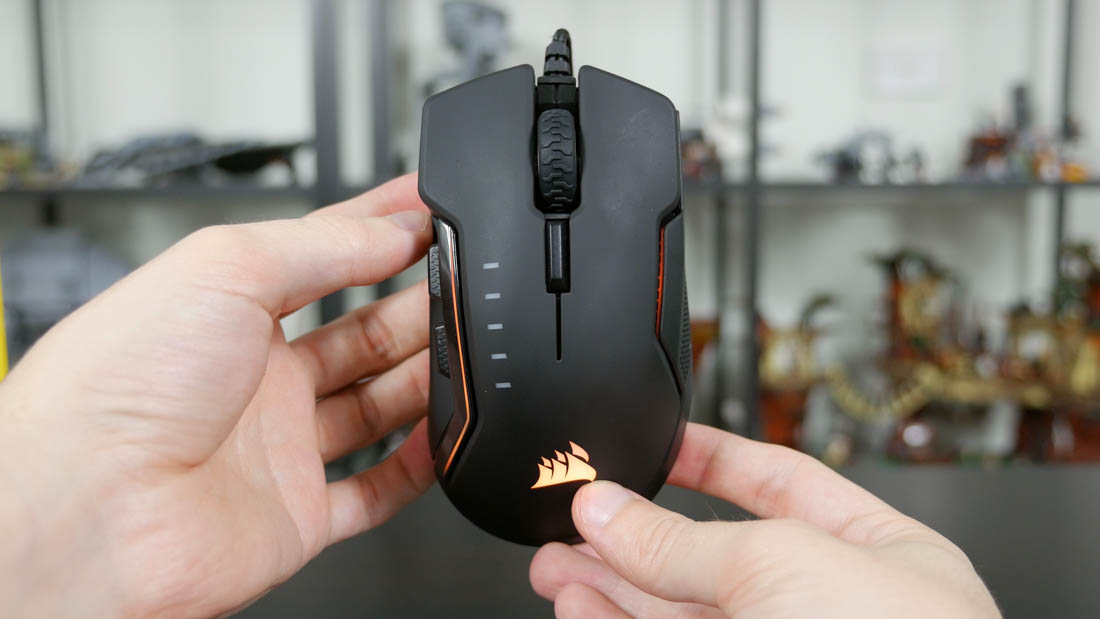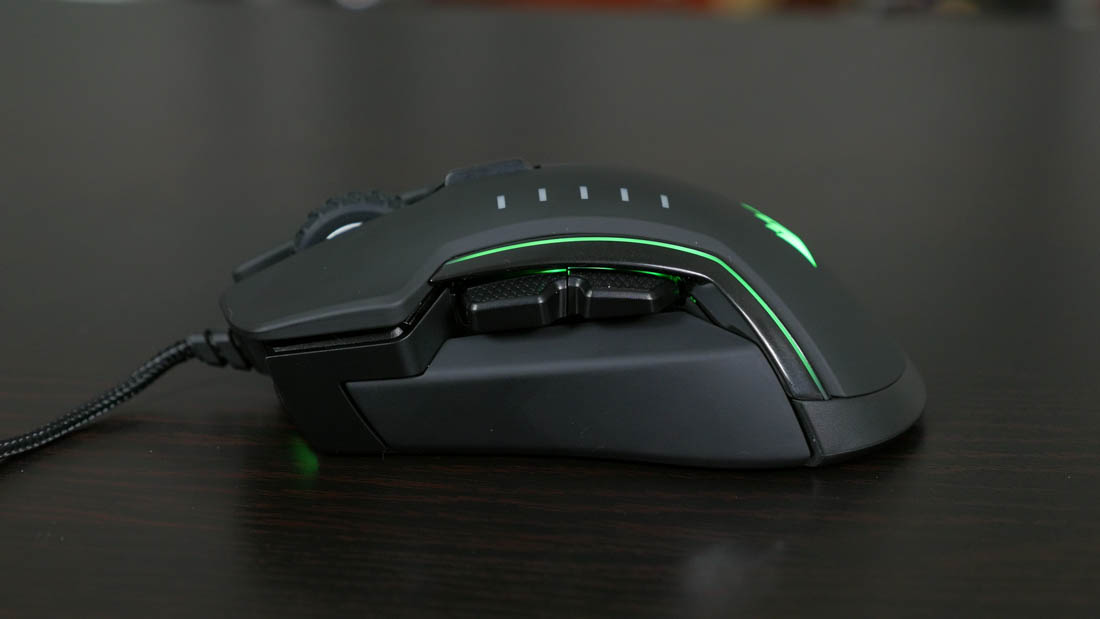I'm a huge fan of Corsair's mechanical gaming keyboards, but I'll admit I had never used a Corsair gaming mouse until the Glaive landed on my desk a couple of weeks ago. As a long-time user of Razer's DeathAdder, I decided to switch over the Glaive full-time to see if it could win me over for everyday and gaming use cases.
The specifications for the Glaive tick pretty much every box: a 16,000 DPI sensor, Omron high-performance switches rated for 50 million clicks, six customizable buttons, a 1000 Hz polling rate, and a total weight (without the braided cable) of 122 grams. You'll even get three RGB lighting zones customizable through Corsair's CUE software. It's no surprise to see the Glaive match Razer's DeathAdder Elite in terms of price, at $69.99, as both pack similar feature sets. This places it in the upper mid-tier of gaming mouse pricing.
The Corsair Glaive's construction is solid as far as mice go. The main body is black plastic - with parts that are silver aluminum - with a soft-touch matte coating for the palm rest. This rest has a great texture, making the mouse feel at home in your hands, while also making it easy to grip.
Along the right edge is a rubberized textured grip for your ring and pinky fingers. There's a glossy black strip on the other side, below which are the forward and back buttons in their own intended section. And on the bottom of the mouse: four large glide-assist pads that allow the Glaive to slide easily over any surface.
The left and right main switches exhibit a decent clicky response, with a light enough actuation force that repetitive clicking in games is a breeze. Whether you press in the middle of the buttons or on the edges, the response is near identical, which gives the impression the Glaive is well built. The scroll wheel has an excellent texture that assists with grip, and the lightly-notched scroll response again feels solid and well-built. Clicking in the scroll wheel takes more force than I'd like, but that's just nitpicking.
The forward and back buttons are in the perfect position for my moderately-sized hands: when I reposition my thumb to access these buttons, only a single motion is required to access either of them, unlike some mice that place only the back button in an ideal ergonomic location. This sort of observation might sound odd, but the fewer times you must reposition your fingers during use, the more comfortable the mouse is to use. Unfortunately the back button is a little spongy; I'd prefer a more defined click here.
The sixth button is located below the scroll wheel, in a position that's difficult to access during normal operation. This is on purpose, as the button is mapped to modify the Glaive's DPI setting by default. Pressing the button toggles through five adjustable DPI settings, and illuminates the appropriate amount of lights on the palm rest to inform you of what DPI preset has been selected. For those that want to set and forget the DPI level, in the Corsair Utility Engine you can remap this button - and any button on the mouse except left click - to whatever function or macro you'd like.
In terms of tracking, the Glaive's 16,000 maximum DPI is way too high for most, unless you require the best possible level of precision in certain games. A DPI of 16,000 is as good as it gets for current gaming mice, so you're definitely not being short changed when it comes to sensitivity, and you never know, such high sensitivity might come in handy one day. Personally, I like a DPI setting in the 2,000 to 3,000 range for everyday use, and the Glaive performs well at this level.
Ergonomically, the Glaive is a very comfortable mouse to use. The palm rest arch is higher than the Deathadder, but I feel this extra height fits my palm in a more comfortable way. The mouse is a great size and weight for both everyday use and gaming, and as I've talked about already, the main buttons are highly accessible. Ergonomics can be a bit subjective though, so I'd recommend you check out and grip the mouse in a store before making a purchase, just to make sure it fits your hand as well. With that said, I think the design of this mouse will be a good fit for most users, especially those who like to palm grip.
I will remind prospective buyers, though, that the Glaive is angled in a way that's only comfortable for right-hand users. Left-hand users should opt for an ambidextrous mouse instead.
One of the Glaive's signature features is the interchangeable thumb grip. Corsair includes three grips in the box, which magnetically detach and clip on with ease. The default grip follows the curves of the mice and uses the same soft-touch texture as the palm rest. There's a textured grip, which uses materials identical to the right side of the mouse and widens the mouse somewhat for those with larger hands. The third grip is also textured, but it adds a paddle rest and keeps the same general width as the default grip.
Choosing grips comes down to personal taste, and I love how Corsair provides options with the Glaive that cover most general mouse styles. Personally, the default grip was the best option for me, however I can easily see how those with larger hands would prefer the extra width of the textured grip. The best part is you can play around with the Glaive after you buy it to see what you like, rather than having to make that choice before you hand over your money and potentially regretting it.
There are three customizable RGB zones on the Glaive: the front, which projects its light subtly onto your mousepad and can't really be seen during normal use; the edges of the palm rest; and the large Corsair logo. The right edge and the Corsair logo are both covered during use, but you can see some of the left light strip. These zones can be modified to whatever color you like, or set to some basic cycling effects, in the Corsair Utility Engine.
RGB lighting on a mouse is more cosmetic than it is on a keyboard, where it helps to illuminate keys and can be seen much more prominently. The Glaive has a decent RGB implementation, though I've seen a few mice (particularly from Razer) that have larger and more visible RGB zones.
Like a lot of gaming mice these days, the Glaive has on-board storage to store your DPI and RGB color profiles, allowing you to setup the mouse on one computer and easily use the same settings on another. Corsair Utility Engine can also perform a surface calibration to give you the best precision possible on your mousepad.
I didn't know what to expect when I received the Glaive, but I'm certainly impressed with the final product. It's a comfortable, solidly-built mouse with a soft-touch plastic finish that feels great in your hands. The interchangeable thumb grip is a unique feature that adds value. It also comes with a class-leading 16,000 DPI sensor for those that want their cursor zooming around the screen at a million miles an hour.
Shopping shortcuts:
- Corsair Glaive RGB Gaming Mouse on Amazon
- Corsair Glaive RGB Gaming Mouse on Newegg
- Corsair Glaive RGB Gaming Mouse on BestBuy
I'm not sure I really want to spend $70 on a gaming mouse, though I am aware more expensive options do exist. However if you do want one of the best mice on the market and you must have features like RGB lighting and a super-high DPI sensor, the Corsair Glaive is a great option.
score
Pros: Super comfortable, soft-touch plastic design. Unique interchangeable thumb rest allows the Glaive to fit all hand sizes. Perfect tracking with high sensitivity. Three-zone RGB lighting with great software controls.
Cons: Competition is just as good at $70.







